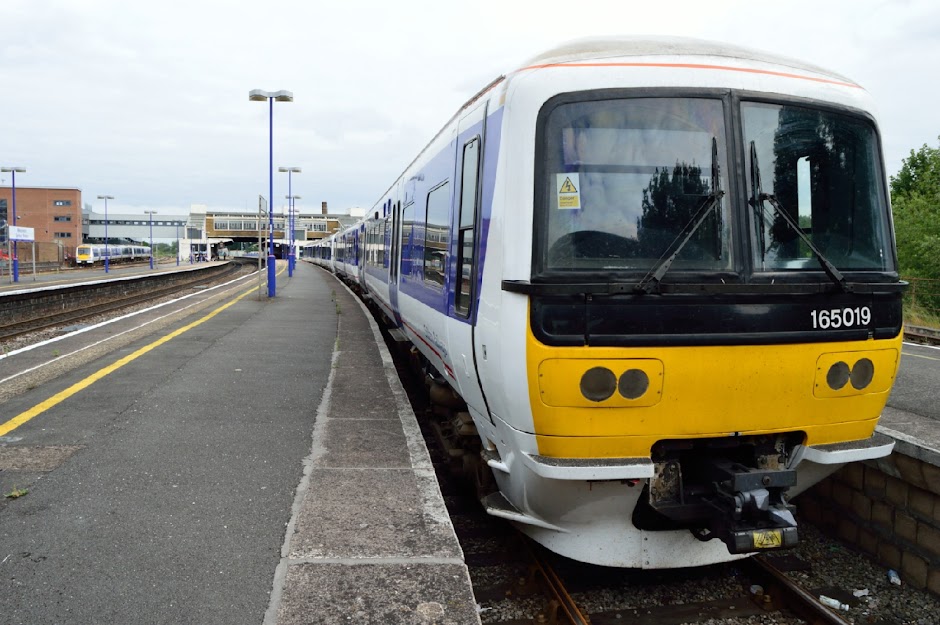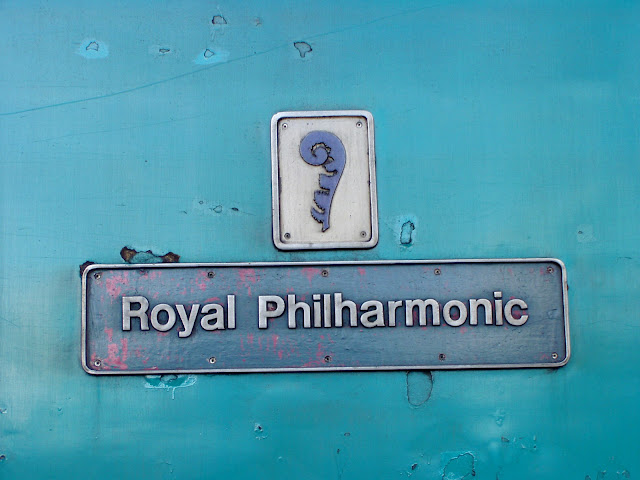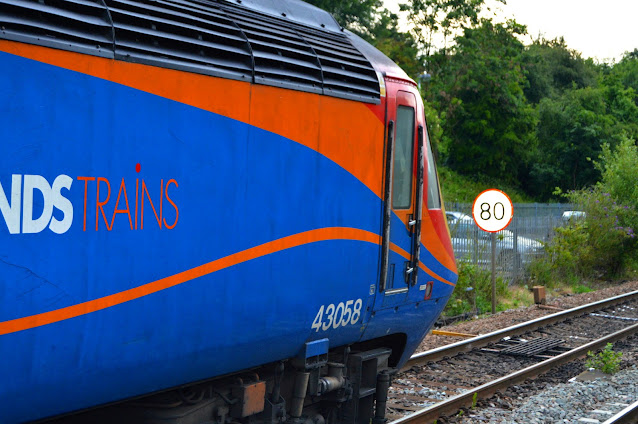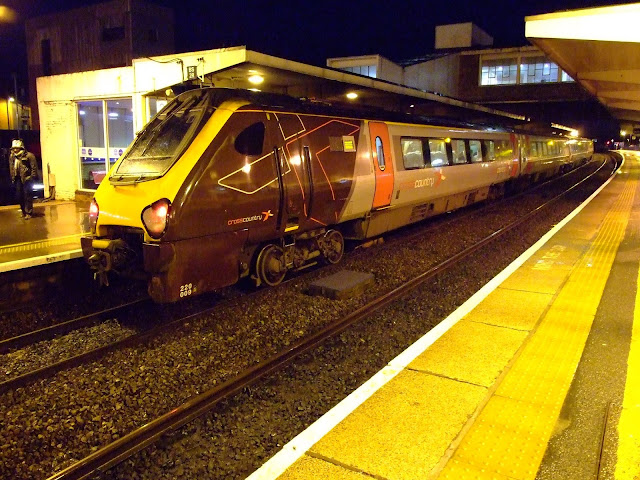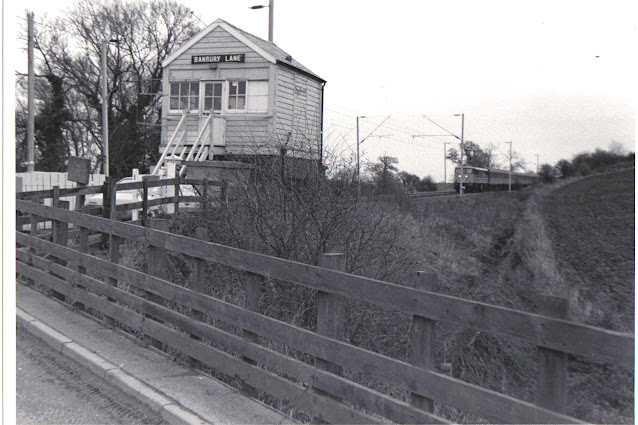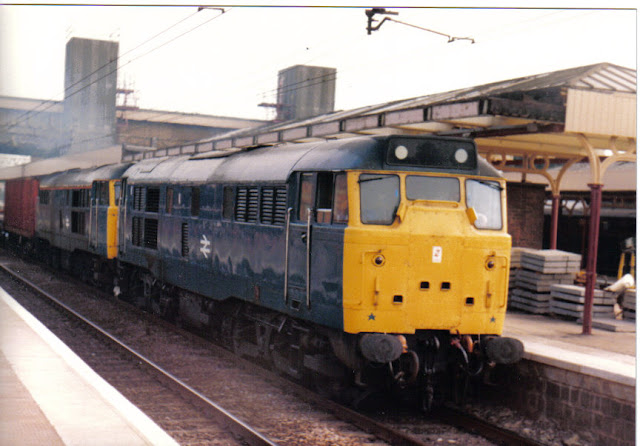31 Class 43 Intercity 125 HST Train Photos
The Class 43 HST trains, also known as the Intercity 125's, were introduced on to the British Rail network in the early 1970's.
Built at British Rail Engineering Ltd., Crewe Works, between 1975 and 1982, 197 sets were manufactured. Initially the classes of power cars were designated '253' and '254'.
Officially, the Brel/Paxman Class 43 (HST) is the fastest diesel locomotive in the world with a maximum speed of 148 mph (238 km/h), though its speed in service is restricted to 125 mph (201 km/h).
*********************************
 |
| Class 43023 HST Photo: Charles Moorhen Rear Power Car 43023 Intercity 125 waits at Didcot station, Oxfordshire. ************************************** |
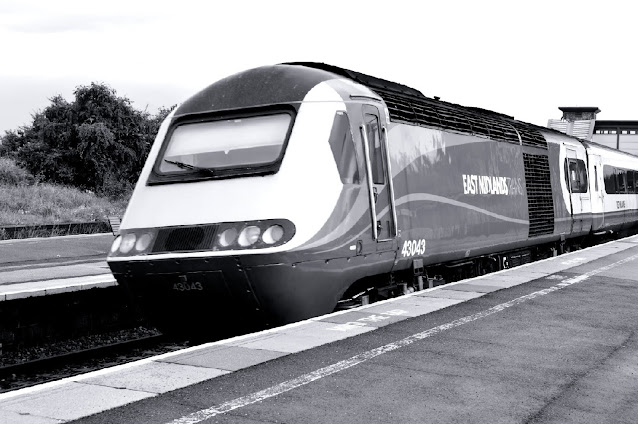 |
| Class 43043 HST Photo: Charles Moorhen
Class 43043 Intercity 125, in East Midlands Trains livery, waits at Wellingborough station, Northamptonshire.
*********************************************
|
 |
| Class 43043 HST Photo: Charles Moorhen
Close-up of Class 43043 Power Car at Wellingborough station, Northamptonshire.
******************************
|
 |
| Class 43044 HST Photo: Charles Moorhen
East Midlands Trains, Class 43044 Intercity 125, powers through Wellingborough station, Northampton, heading north.
******************************
|
Class 43047 HST
Photo: Charles Moorhen
Photo: Charles Moorhen
East Midlands Trains Class 43047 Intercity 125 passes through Wellingborough station heading for London St. Pancras.
************************************************
Class 43048 HST
Photo: Charles Moorhen
Photo: Charles Moorhen
East Midlands Trains, Class 43048 Intercity 125, pulls away from Wellingborough station forming the rear power car of a train heading north.
****************************************************
Class 43050 HST
Photo: Charles Moorhen
Photo: Charles Moorhen
Intercity 125 Class 43050, in East Midlands Trains livery, enters Wellingborough station heading a train going north from St. Pancras.
*****************************************************
Class 43055 HST
Photo: Charles Moorhen
Photo: Charles Moorhen
Forming the rear of a train waiting at Wellingborough station, East Midlands Trains Class 43055 Intercity 125 is about to head north.
*******************************************************
Class 43058 HST
Photo: Charles Moorhen
Photo: Charles Moorhen
Close-up photo of the side of East Midlands Trains power car Class 43058 Intercity 125 standing at Wellingborough station.
*********************************************
Class 43066 HST
Photo: Charles Moorhen
Photo: Charles Moorhen
Night photo of East Midlands Trains Class 43066 Intercity 125 waiting at Wellingborough before heading south to London St. Pancras.
*******************************************
Class 43066 HST
Photo: Charles Moorhen
Photo: Charles Moorhen
Class 43066 passes through Wellingborough station heading north.
****************************
Class 43069 HST
Photo: Charles Moorhen
Photo: Charles Moorhen
Class 43069 Intercity 125 in Midland Mainline 'Meridian' livery stands at platform 1, Wellingborough station.
**************************************
Class 43075 HST
Photo: Charles Moorhen
Photo: Charles Moorhen
On a service heading north, East Midlands Trains Class 43075 Intercity 125, waits at Wellingborough station.
*************************************************
Class 43075 HST
Photo: Charles Moorhen
Photo: Charles Moorhen
East Midlands Trains Class 43075 powers into Wellingborough station heading towards London St. Pancras.
*******************************************************
Class 43079 HST
Photo: Charles Moorhen
Class 43079, in Intercity livery, enters Basingstoke station in the 1990's.
*********************************
Class 43079 HST
Photo: Charles Moorhen
Class 43079, in Intercity livery, enters Basingstoke station in the 1990's.
*********************************
Class 43081 HST
Photo: Charles Moorhen
Photo: Charles Moorhen
East Midlands Trains Class 43081 Intercity 125 waits at Wellingborough station before continuing its run north.
*****************************************************
Class 43082 HST
Photo: Charles Moorhen
Photo: Charles Moorhen
As the sun sets on Class 43082 Intercity 125, in Midland Mainline livery it stands at platform 1, Wellingborough station.
****************************************************
Class 43083 HST
Photo: Charles Moorhen
Photo: Charles Moorhen
East Midlands Trains Class 43083 Intercity 125 photographed powering through Wellingborough station heading north.
********************************************
Class 43083 HST
Photo: Charles Moorhen
East Midlands Train Class 43083 Intercity 125 waits at Bedford for the all clear to proceed north.
*****************************************
Class 43089 HST
Photo: Charles Moorhen
Class 43089 in early Intercity 125 livery waits at platform 1, Wellingborough station, before heading north.
*****************************************************
Class 43083 HST
Photo: Charles Moorhen
East Midlands Train Class 43083 Intercity 125 waits at Bedford for the all clear to proceed north.
*****************************************
Class 43089 HST
Photo: Charles Moorhen
Class 43089 in early Intercity 125 livery waits at platform 1, Wellingborough station, before heading north.
*****************************************************
Class 43089 HST
Photo: Charles Moorhen
Photo: Charles Moorhen
Looking totally different in East Midlands Trains livery, amid the long shadows of late afternoon, Class 43089 Intercity 125 thunders through Wellingborough station as can be seen by the exhaust smoke above the power car.
*********************************
Class 43098 HST
Photo: Charles Moorhen
Class 43098 in 'Swallow' Intercity livery makes a smoky start from Basingstoke station in the 1990's.
***********************************
Class 43116 HST
Photo: Charles Moorhen
Class 43116, in early Intercity 125 livery, waits at platform 2, Wellingborough station, before continuing south to London St. Pancras.
*********************************************************
Class 43098 HST
Photo: Charles Moorhen
Class 43098 in 'Swallow' Intercity livery makes a smoky start from Basingstoke station in the 1990's.
***********************************
Class 43116 HST
Photo: Charles Moorhen
Class 43116, in early Intercity 125 livery, waits at platform 2, Wellingborough station, before continuing south to London St. Pancras.
*********************************************************
Class 43126 HST
Photo: Charles Moorhen
Photo: Charles Moorhen
In 'Fag Packet' livery, First Great Western Class 43126 Intercity 125 stands at Didcot station, Oxfordshire.
***************************************
Class 43151 HST
Photo: Charles Moorhen
Photo: Charles Moorhen
First Great Western train, Class 43151 Intercity 125, stands in St. Austell station, Cornwall, before continuing its journey to London Paddington.
************************************
Unidentified Class 43 HST
Photo: Charles Moorhen
Photo: Charles Moorhen
Unidentified First Great Western Class 43 Intercity 125 about to enter Didcot station en route to the south-west.
***********************************
Don't forget to subscribe to 'Along These Tracks' to get all new posts and updates sent directly to you.
Blog update:
Previous photo posts are now easier to find.
All blog posts are now listed alphabetically on the right side of your screen; under the heading, 'Previous Photo Posts'.
"I hope this makes your search easier".
Previous photo posts are now easier to find.
All blog posts are now listed alphabetically on the right side of your screen; under the heading, 'Previous Photo Posts'.
"I hope this makes your search easier".
